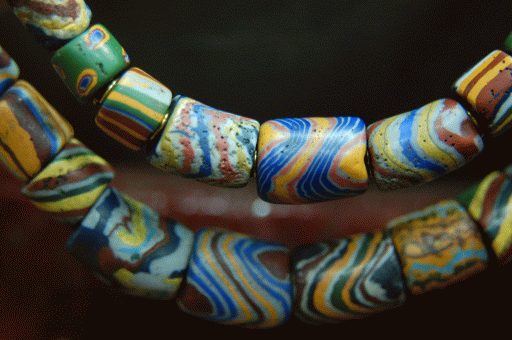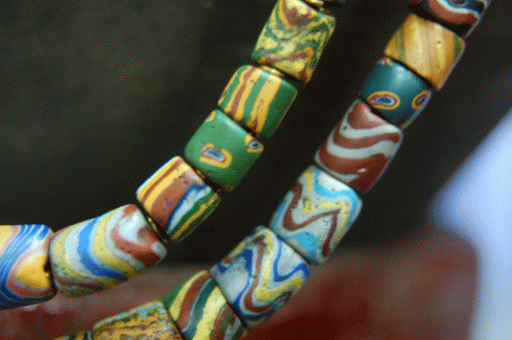![]() Potteries
Potteries ![]() Lazurite Beads
Lazurite Beads ![]() Chiefains’Emblems
Chiefains’Emblems
![]() Headdress and Eagle Feather
Headdress and Eagle Feather ![]() Spirits of Paiwan
Spirits of Paiwan
Lazurite Beads is one of the three treasures in Paiwan Tribe. Nobody knows its manufacturing method from Japanese-occupied age to the early time of Recovery. In 1980s, Paiwan Tribe’s clansman Leichi started to make research and develop the manufacturing method of Lazurite Beads. At that time, Leichi used oxygen and coal gas as fuel to melt the glass stick and the glass through pipeline. The melted glass is adhered with fire-resistant sticks and shaped by rolling on abraders. Then the shaped glass beads are colored by using flower-pattern fiberglass, and turned into finished product after cooling.
Disputes over the origin of traditional lazurite beads still exist. According to literature, Paiwan Tribe’s lazurite beads contain a big share of lead but no barium. This manufacturing method may originate from the time Paiwan Tribe’s ancestors migrate to Taiwan. This analysis comes from Southeast Asia. Otherwise, Paiwan Tribe is in possession of Southeast Asia Lazurite Beads that other tribes do not have. So the time Paiwan Tribe migrated to Taiwan should not earlier than the initial stages of A.D., when Lazurite Beads were not yet substantively distributed in Southeast Asia.



Somebody claimed that Lazurite Beads came from Europe. They said that Southern Asia has traffic with Europe so that they might exchange their spices for the precious lazurite beads. Some scholars reveals that Borneo’s aborigines had similar Lazurite Beads, they presumed that Paiwan Tribe might be aborigines in Borneo and ferried to Taiwan with Lazurite Beads between the 13th and 15th century.
Some scholars heard from Paiwan Tribe’s elders that their ancestors got Lazurite Beads from Balaca, who was Dutchmen having occupied Taiwan. According to a report from Netherland, Lazurite Beads were included in trades between Dutchmen and local tribe in Taiwan.
Someone said Paiwan Tribe gained Lazurite Beads from the Chinese, but these beads should be acquired later.
There are various Lazurite Beads, but according as the meaning of Lazurite Beads, there should be several categories as follows:
|
Beads of Dignity and Beauty (Mulimulidan) Mulimulidan, with about 20 varieties, is most precious in Paiwan Tribe’s Lazurite Beads. Each variety has its own special name. In chiefain’s weddings, Mulimulidan in the betrothal gift that symbolizes its identity and status. One name of Mulimulidan is Light of Sun, symbolizing the chiefain stands high above the masses and is different from common people. That means if you look at his face, you will hurt by a strong sunlight glaring on your eyes. It is said that the ancestor Dawejon of Chaoboobol subtribe is Sun God’s avatar who has the capability of controlling the forces of nature. Mulimulidan is his proprietary baldric. |
|
Beads of Peacock(Za-aw) Za-aw, with 5 varieties of old-bead style, is the masterpiece in Mulimulidans. There is a story about Za-aw. One day, God in Heaven turned himself into a peacock and came down to the world. He saw the daughter of the chiefain was washing clothes at the bank of rivulet when curveting along the rivulet. He fell in love with her and wanted to marry her. But the chiefain refused his request of marriage. Peacock grieved over it. He flew to the sky and sprinkled down a lot of beautiful beads. The chiefain adored these beads and felt regretful for his refusal. He finally agreed the marriage between his daughter and Peacock. At the wedding night, Peacock turned himself to a man and flew together with his newly married princess to the remote horizon. |
|
Tear of Sun(Lozegnagadaw) There was a story about Tear of Sun. A long time ago, the sun was in a quite low position and very close to the roof. Due to this reason, people were dazed by the glare of sun. It is so hot that One woman in Paiwan Tribe couldn’t bear it. She went into her kitchen and fetched out 5 millets. She cooked these millets to produce heated steam to drive the sun away. When the millets become cooked, the sun was pushed up into high altitude. The sun could not help weeping over his leaving and dropping tear. The tear was turned into beautiful beads that are now called Tear of Sun. |
|
Beads of Hands and Feet(Magazaigaw) A long time ago, a chiefain in East Taiwan married a girl who comes from a distant place. After their marriage, his wife unexpectedly procreated a “pomelo”. People in this village laughed at her privately and even looked down on her. But this poor mother still looked after her “child” with love and chariness. As time went by, a lot of beautiful beads came out near the pomelo. Afterwards, as the pomelo grew up, more and more beads came out. Finally a miracle occurred, these beads were linked with the pomelo and turned into limbs, and the pomelo also became a smart boy. Everybody loved this cherubic boy. These beads were Magazaigaws. This story educates clansmen to respect others and not to look know down on anybody. |
|
Beads of Land(Cadacada-an) Long time ago, a chiefain saw that a group of ants ceaselessly conveyed beads into their residence. He was very interested with this and went along the ants’ path to look for the reason. He finally found an entry to a big hole under a big stone. He assigned some persons to dig alonge the hole. At the end of the hole, he found a group of ants surrounded a pile of beads and continuously conveyed these beads. And then the chiefain helped the ants to carry these beads back to their residence and build nests on both end of the hole for the ants. He claimed that the land between the two nests should belong to him. The beards those ants conveyed were Cadacada-an. It symbolized the land authority in early Paiwan Tribe society. If a chiefain claimed the range of his land and some one disagreed, he should take out his Cadacada-an as an evidence. |
|
Beads of Eyes(Pumacamaca) Maca means eyes in Paiwan Tribe language. There is a bunch of Pumacamaca on a traditional necklace providing for protection of the necklace. It is said that somebody once took up a necklace with a bunch of Pumacamaca on and his family then led to poverty. This is because Pumacamaca has a meaning of chastisement. Among the old-age beads, Pumacamaca has a lot of colors, such as black, green transparency and yellow etc. The most visible feature is its eyes-like totem grain. Since it is Bead of Eyes, it has the function of guarding and blessing. |
|
Beads of Warrior (Malaligai) When warriors win a battle and came back, they will receive Beads of Warrior from the chieftain as their symbol of Warrior. |
|
Beads of Weaver(palic) Ppalic symbolizes the carefulness and handicraft of women. Palic means bead of craft and weaving. The girls take up strings of bangles or necklaces to help them learn how to weave. Palics are medium-class Lazurite Beads. An old and well-known family will use palics as their betrothal gift. |








